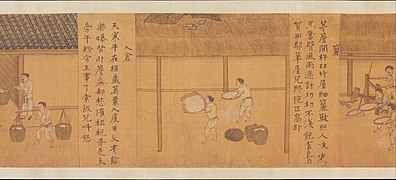Agriculture in China
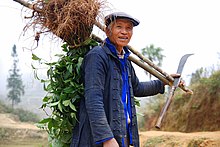

China primarily producesrice,wheat,potatoes,tomato,sorghum,peanuts,tea,millet,barley,cotton,oilseed,cornandsoybeans.
History[edit]
The development of farming over the course ofChina's historyhas played a key role in supporting the growth of one of the largest populations in the world.
Archaeology[edit]
Analysis of stone tools by ProfessorLiu Liand others has shown thathunter-gatherers23,000–19,500 years ago ground wild plants with the same tools that would later be used for millet and rice.[1]
Domesticated millet varietiesPanicum miliaceumandSetaria italicamay have originated in Northern China.[2]Remains of domesticatedmillethave been found in northern China atXinglonggou,Yuezhang,Dadiwan,Cishan,and severalPeiligangsites. These sites cover a period over 7250-6050BCE.[3]The amount of domesticated millet eaten at these sites was proportionally quite low compared to other plants. At Xinglonggou, millet made up only 15% of all plant remains around7200-6400 BCE;a ratio that changed to 99% by 2050-1550 BCE.[4]Experiments have shown that millet requires very little human intervention to grow, which means that obvious changes in the archaeological record that could demonstrate millet was being cultivated do not exist.[3]
Excavations atKuahuqiao,the earliest knownNeolithicsite in eastern China, have documented rice cultivation 7,700 years ago.[5]Approximately half of the plant remains belonged to domesticatedjaponica species,whilst the other half were wild types of rice. It is possible that the people at Kuahuqiao also cultivated the wild type.[3]Finds at sites of theHemuduCulture (c.5500-3300 BCE) inYuyaoandBanponearXi'anincludemilletand spade-like tools made of stone and bone. Evidence of settled rice agriculture has been found at the Hemudu site of Tianluoshan (5000-4500 BCE), with rice becoming the backbone of the agricultural economy by theMajiabang cultureinsouthern China.[6]According to theRecords of the Grand Historiansome female prisoners in historic times were given the punishment to be "grain pounders" (Chinese:Hình giã) as an alternative to more severe corporal punishment like tattooing or cutting off a foot. Some scholars believe the four or five year limits on these hard labor sentences began withEmperor Wen's legal reforms.[7]
There is also a long tradition involvingagriculture in Chinese mythology.In his book Permanent Agriculture: Farmers of Forty Centuries (1911), ProfessorFranklin Hiram Kingdescribed and extolled the values of the traditional farming practices ofChina.[8]
Farming method improvements[edit]

Farming in China has always been verylabor-intensive.However, throughout its history, various methods have been developed or imported that enabled greater farming production and efficiency. They also utilized theseed drillto help improve on row farming.
During theSpring and Autumn period(722–481 BC), two revolutionary improvements infarming technologytook place. One was the use ofcast iron toolsandbeasts of burdento pull plows, and the other was the large-scale harnessing of rivers and development ofwater conservationprojects. The engineerSunshu Aoof the 6th century BC andXimen Baoof the 5th century BC are two of the oldest hydraulic engineers from China, and their works were focused on improvingirrigationsystems.[9]These developments were widely spread during the ensuingWarring States period(403–221 BC), culminating in the enormousDu Jiang Yan Irrigation Systemengineered byLi Bingby 256 BC for theState of Qinin ancientSichuan.
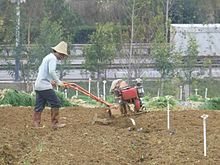
For agricultural purposes the Chinese had invented the hydraulic-poweredtrip hammerby the 1st century BC, during the ancientHan dynasty(202 BC-220 AD).[10]Although it found other purposes, its main function was to pound, decorticate, and polish grain that otherwise would have been done manually. The Chinese also innovated the square-palletchain pumpby the 1st century AD, powered by awaterwheeloroxenpulling on a system of mechanical wheels.[11]Although the chain pump found use inpublic worksof providing water for urban and palatialpipe systems,[12]it was used largely to lift water from a lower to higher elevation in filling irrigationcanalsandchannelsforfarmland.[13]
Chinese ploughs from Han times on fulfil all these conditions of efficiency nicely, which is presumably why the standard Han plough team consisted of two animals only, and later teams usually of a single animal, rather than the four, six or eight draught animals common in Europe before the introduction of the curved mould-board and other new principles of design in the + 18th century. Though the mould-board plough first appeared in Europe in early medieval, if not in late Roman, times, pre-eighteenth century mould-boards were usually wooden and straight (Fig. 59). The enormous labour involved in pulling such a clumsy construction necessitated large plough-teams, and this meant that large areas of land had to be reserved as pasture. In China, where much less animal power was required, it was not necessary to maintain the mixed arable-pasture economy typical of Europe: fallows could be reduced and the arable area expanded, and a considerably larger population could be supported than on the same amount of land in Europe.[14]
— Francesca Bray
During theEastern Jin(317–420) and theNorthern and Southern Dynasties(420–589), theSilk Roadand other international trade routes further spread farming technology throughout China. Political stability and a growing labor force led to economic growth, and people opened up large areas of wasteland and built irrigation works for expanded agricultural use. As land-use became more intensive and efficient, rice was grown twice a year and cattle began to be used forplowingandfertilization.
By theTang dynasty(618–907), China had become a unified feudal agricultural society again. Improvements in farming machinery during this era included themoldboard plowandwatermill.Later during theYuan dynasty(1271–1368), cotton planting and weaving technology were extensively adopted and improved.
While around 750, 75% of China's population lived north of the riverYangtze,by 1250, 75% of the population lived south of the river. Such large-scale internal migration was possible due to the introduction of quick-ripening strains of rice from Vietnam suitable for multi-cropping.[15]This is also possibly the result of Northern China falling to invaders. With the hardships that come from conflict, many Chinese may have moved South to not starve.
The Yuan, Ming, and Qing dynasties had seen the rise of collective help organizations between farmers.[16]
In 1909 US Professor of AgricultureFranklin Hiram Kingmade an extensive tour of China (as well as Japan and briefly Korea) and he described contemporary agricultural practices. He favourably described the farming of China as 'permanent agriculture' and his book 'Farmers of Forty Centuries', published posthumously in 1911, has become an agricultural classic and has been a favoured reference source fororganic farmingadvocates. The book has inspired manycommunity-supported agriculturefarmers in China to conductecological farming.[17]
-
Scroll depicting rice production,Yuan dynasty
People's Republic of China[edit]

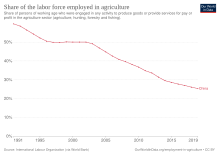

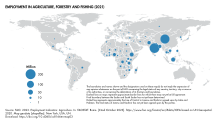
Following theChinese Communist Party's victory in theChinese Civil War,control of the farmlands was taken away from landlords and redistributed to the 300 million peasant farmers,[18]including purges of landlords during theLand Reform Movement.In 1952, gradually consolidating its power following the civil war, the government began organizing the peasants into teams. Three years later, these teams were combined into producer cooperatives, enacting thesocialistgoal of collective land ownership. In the following year, 1956, the government formally took control of the land, further structuring the farmland into large government-operated collective farms.
Collectivizationwas a factor in the most important change in Chinese agriculture in the dramatic increase in irrigated land during the early and mid-1950s.[19]: 111 Collectivization also helped facilitate the labor-intensive practice ofdouble-croppingin southern China, which greatly increased agricultural yields.[19]: 116
In the 1958 "Great Leap Forward"campaign initiated byChairman of the Chinese Communist PartyMao Zedong,land use was placed under closer government control in an effort to improve agricultural output. In particular, theFour Pests campaignand mass eradication of sparrows had a direct negative impact on agriculture. Collectives were organized intocommunes,private food production was banned, and collective eating was required. Greater emphasis was also put onindustrializationinstead of agriculture. The farming inefficiencies created by this campaign led to theGreat Chinese Famine,resulting in the deaths of somewhere between the government estimate of 14 million to scholarly estimates of 20 to 43 million.[20]Although private plots of land were re-instated in 1962 due to this failure, communes remained the dominant rural unit of economic organization during theCultural Revolution,with Mao championing the "Learn from Dazhai in agriculture"campaign. Tachai's semi-literate party secretaryChen Yongguiwas among those outmaneuvered byDeng Xiaopingafter the death of Mao: from 1982 to 1985, theDazhai-style communes were gradually replaced bytownships.
Beginning in 1978, as part of theFour Modernizationscampaign, the Family Production Responsibility System was created, dismantling communes and giving agricultural production responsibility back to individual households. Households are now given crop quotas that they were required to provide to their collective unit in return for tools, draft animals, seeds, and other essentials. Households, which now lease land from their collectives, are free to use their farmland however they see fit as long as they meet these quotas. This freedom has given more power to individual families to meet their individual needs. In addition to these structural changes, the Chinese government also engages inirrigationprojects (such as theThree Gorges Dam), runs large state farms, and encouragesmechanizationandfertilizeruse.[21]
By 1984, when about 99% of farm production teams had adopted the Family Production Responsibility System, the government began further economic reforms, aimed primarily at liberalizing agricultural pricing and marketing. In 1984, the government replaced mandatory procurement with voluntary contracts between farmers and the government. Later, in 1993, the government abolished the 40-year-old grain rationing system, leading to more than 90 percent of all annual agricultural produce to be sold at market-determined prices.

Since 1994, the government has instituted a number of policy changes aimed at limiting grain importation and increasing economic stability. Among these policy changes was the artificial increase of grain prices above market levels. This has led to increased grain production, while placing the heavy burden of maintaining these prices on the government. In 1995, the "Governor's Grain Bag Responsibility System" was instituted, holding provincial governors responsible for balancing grain supply and demand and stabilizing grain prices in their provinces. Later, in 1997, the "Four Separations and One Perfection" program was implemented to relieve some of the monetary burdens placed on the government by its grain policy.[22]
As China continues to industrialize, vast swaths of agricultural land are being converted into industrial land. Farmers displaced by such urban expansion often becomemigrant laborforfactories,but other farmers feel disenfranchised and cheated by the encroachment of industry and the growing disparity between urban and rural wealth and income.[23]
The most recent innovation in Chinese agriculture is a push intoorganic agriculture.[24]This rapid embrace of organic farming simultaneously serves multiple purposes, including food safety, health benefits, export opportunities, and, by providing price premiums for the produce of rural communities, the adoption of organics can help stem the migration of rural workers to the cities.[24]In the mid-1990s China became a net importer of grain, since its unsustainable practises of groundwater mining has effectively removed considerable land from productive agricultural use.[citation needed]
As of 2023, approximately 40% of China's workforce is engaged in farming, primarily at small scale.[25]: 174 Agricultural production accounts for less than 9% of China's GDP.[25]: 174
Major agricultural products[edit]
Crop distribution[edit]

Although China's agricultural output is the largest in the world, only 10% of its total land area can be cultivated. China's arable land, which represents 10% of the total arable land in the world, supports over 20% of the world's population.[26]Of this approximately 1.4 million square kilometers of arable land, only about 1.2% (116,580 square kilometers) permanently supports crops and 525,800 square kilometers are irrigated.[citation needed]The land is divided into approximately 200 million households, with an average land allocation of just 0.65 hectares (1.6 acres).
China's limited space for farming has been a problem throughout its history, leading to chronic food shortage and famine. While the production efficiency of farmland has grown over time, efforts to expand to the west and the north have met with limited success, as such land is generally colder and drier than traditional farmlands to the east. Since the 1950s, farm space has also been pressured by the increasing land needs of industry and cities.
Peri-urban agriculture[edit]

Such increases in the sizes of cities, such as the administrative district ofBeijing's increase from 4,822 km2(1,862 sq mi) in 1956 to 16,808 km2(6,490 sq mi) in 1958, has led to the increased adoption ofperi-urban agriculture.Such "suburban agriculture" led to more than 70% of non-staple food in Beijing, mainly consisting of vegetables and milk, to be produced by the city itself in the 1960s and 1970s. Recently, with relative food security in China, periurban agriculture has led to improvements in the quality of the food available, as opposed to quantity. One of the more recent experiments in urban agriculture is the Modern Agricultural Science Demonstration Park inXiaotangshan.[27]
Food crops[edit]


About 75% of China's cultivated area is used for food crops.Riceis China's most important crop, raised on about 25% of the cultivated area. The majority of rice is grown south of theHuai River,in theZhu Jiangdelta, and in theYunnan,Guizhou,andSichuanprovinces.
Wheatis the second most-prevalent grain crop, grown in most parts of the country but especially on theNorth China Plain,theWeiandFen Rivervalleys on theLoess plateau,and inJiangsu,Hubei,and Sichuan provinces.Cornandmilletare grown in north and northeast China, andoatsare important inInner MongoliaandTibet.
Other crops include sweet potatoes in the south, whitepotatoesin the north (China is the largest producer of potatoes in the world), and various other fruits and vegetables. Tropical fruits are grown onHainan Island,applesandpearsare grown in northernLiaoningandShandong.
Oil seeds are important in Chinese agriculture, supplying edible and industrial oils and forming a large share of agricultural exports. In North and Northeast China, Chinese soybeans are grown to be used in tofu and cooking oil. China is also a leading producer of peanuts, which are grown in Shandong and Hebei provinces. Other oilseed crops aresesame seeds,sunflower seeds,rapeseed,and the seeds of thetung tree.
Citrusis a major cash crop in southern China, with production scattered along and south of the Yangtze River valley.Mandarinsare the most popular citrus in China, with roughly double the output of oranges.[28]
Other important food crops for China includegreenandjasmine teas(popular among the Chinese population),black tea(as an export),sugarcane,andsugar beets.Tea plantations are located on the hillsides of the middle Yangtze Valley and in the southeast provinces ofFu gianandZhe gian g.Sugarcane is grown inGuangdongand Sichuan, while sugar beets are raised inHeilong gian gprovince and on irrigated land in Inner Mongolia.Lotusis widely cultivated throughout southern China.[29][30]
Arabica coffeeis grown in the southwestern province ofYunnan.[31]Much smaller plantations also exist inHainanandFu gian.[32]
Fiber crops[edit]
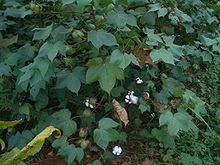
China is the leading producer ofcotton,which is grown throughout, but especially in the areas of the North China Plain, the Yangtze river delta, the middle Yangtze valley, and theXin gian g Uygur Autonomous Region.Other fiber crops includeramie,flax,jute,andhemp.Sericulture,the practice of silkworm raising, is also practiced in central and southern China.
Livestock[edit]
China has a large livestock population, withpigsandfowlsbeing the most common. China's pig population and pork production mainly lie along the Yangtze River. In 2011, Sichuan province had 51 million pigs (11% of China's total supply).[33]In rural western China,sheep,goats,andcamelsare raised bynomadic herders.[34]In Tibet,yaksare raised as a source of food, fuel, and shelter.Cattle,water buffalo,horses,mules,anddonkeysare also raised in China, anddairyhas recently been encouraged by the government, even though approximately 92.3% of the adult population is affected by some level oflactose intolerance.
As demand for gourmet foods grows, production of more exotic meats increases as well. Based on survey data from 684 Chineseturtle farms(less than half of the all 1,499 officially registeredturtle farmsin the year of the survey, 2002), they sold over 92,000 tons of turtles (around 128 million animals) per year; this is thought to correspond to the industrial total of over 300 million turtles per year.[35]
Increased incomes and increased demand for meat, especially pork, has resulted in demand for improved breeds of livestock, breeding stock imported particularly from the United States. Some of these breeds are adapted tofactory farming.[36]
Fishing[edit]
China accounts for about one-third of the total fish production of the world.Aquaculture,the breeding of fish in ponds and lakes, accounts for more than half of its output. The principal aquaculture-producing regions are close to urban markets in the middle and lower Yangtze valley and the Zhu Jiang delta.
Production[edit]
In its first fifty years, thePeople's Republic of Chinagreatly increased agricultural production through organizational and technological improvements. As of at least 2022, China produces almost all of its own food and non-soybean feed.[19]: 230
| Crop[37] | 1949Output (tons) | 1978Output (tons) | 1999Output (tons) | |
| 1. | Grain | 113,180,000 | 304,770,000 | 508,390,000 |
| 2. | Cotton | 444,000 | 2,167,000 | 3,831,000 |
| 3. | Oil-bearing crops | 2,564,000 | 5,218,000 | 26,012,000 |
| 4. | Sugarcane | 2,642,000 | 21,116,000 | 74,700,000 |
| 5. | Sugarbeet | 191,000 | 2,702,000 | 8,640,000 |
| 6. | Flue-cured tobacco | 43,000 | 1,052,000 | 2,185,000 |
| 7. | Tea | 41,000 | 268,000 | 676,000 |
| 8. | Fruit | 1,200,000 | 6,570,000 | 62,376,000 |
| 9. | Meat | 2,200,000 | 8,563,000 | 59,609,000 |
| 10. | Aquatic products | 450,000 | 4,660,000 | 41,220,000 |
As of 2011, China was both the world's largest producer and consumer of agricultural products.[38][39]However, the researcher Lin Erda has stated a projected fall of possibly 14% to 23% by 2050 due to water shortages and other impacts by climate change; China has increased the budget for agriculture by 20% in 2009, and continues to support energy efficiency measures, renewable technology, and other efforts with investments, such as the over 30% green component of the $586bn fiscal stimulus package announced in November 2008.[40]
In 2018:[41]
- It was the 2nd largest producer ofmaize(257.1 million tons), second only to the USA;
- It was the largest producer ofrice(212.1 million tons);
- It was the largest producer ofwheat(131.4 million tons);
- It was the 3rd largest producer ofsugarcane(108 million tons), second only to Brazil and India;
- It was the largest producer ofpotato(90.2 million tons);
- It was the largest producer ofwatermelon(62.8 million tons);
- It was the largest producer oftomatoes(61.5 million tons);
- It was the largest producer ofcucumber/pickles(56.2 million tons);
- It was the largest producer ofsweet potato(53.0 million tons);
- It was the largest producer ofapple(39.2 million tons);
- It was the largest producer ofeggplant(34.1 million tons);
- It was the largest producer ofcabbage(33.1 million tons);
- It was the largest producer ofonion(24.7 million tons);
- It was the largest producer ofspinach(23.8 million tons);
- It was the largest producer ofgarlic(22.2 million tons);
- It was the largest producer ofgreen bean(19.9 million tons);
- It was the largest producer oftangerine(19.0 million tons);
- It was the largest producer ofcarrots(17.9 million tons);
- It was the 3rd largest producer ofcotton(17.7 million tons), second only to India and the USA;
- It was the largest producer ofpeanut(17.3 million tons);
- It was the largest producer ofpear(16.0 million tons);
- It was the 4th largest producer ofsoy(14.1 million tons), losing to the US, Brazil and Argentina;
- It was the largest producer ofgrape(13.3 million tons);
- It was the 2nd largest producer ofrapeseed(13.2 million tons), second only to Canada;
- It was the largest producer ofpea(12.9 million tons);
- It was the largest producer ofmelon(12.7 million tons);
- It was the 8th largest producer ofsugar beet(12 million tons), which serves to producesugarandethanol;
- It was the 2nd largest producer ofbanana(11.2 million tons), second only to India;
- It was the largest producer ofcauliflowerandbroccoli(10.6 million tons);
- It was the 2nd largest producer oforange(9.1 million tons), second only to Brazil;
- It was the largest producer ofpumpkin(8.1 million tons);
- It was the largest producer ofasparagus(7.9 million tons);
- It was the largest producer ofplum(6.7 million tons);
- It was the largest producer ofmushroomandtruffle(6.6 million tons);
- It was the largest producer ofgrapefruit(4.9 million tons);
- It was the 15th largest producer ofcassava(4.9 million tons);
- It was the 2nd largest producer ofmango(includingmangosteenandguava) (4.8 million tons), second only to India;
- It was the largest producer ofpersimmon(3.0 million tons);
- It was the largest producer ofstrawberry(2.9 million tons);
- It was the largest producer oftea(2.6 million tons);
- It produced 2.5 million tons ofsunflower seed;
- It was the 3rd largest producer oflemon(2.4 million tons), second only to India and Mexico;
- It was the largest producer oftobacco(2.2 million tons);
- It was the 8th largest producer ofsorghum(2.1 million tons);
- It was the largest producer ofkiwi(2.0 million tons);
- It was the largest producer ofchestnut(1.9 million tons);
- It produced 1.9 million tons oftaro;
- It produced 1.8 million tons offava beans;
- It was the 3rd largest producer ofmillet(1.5 million tons), second only to India and Niger;
- It was the 8th largest producer ofpineapple(1.5 million tons);
- It produced 1.4 million tons ofbarley;
- It was the largest producer ofbuckwheat(1.1 million tons);
- It was the 6th largest producer ofoats(1 million tons);
- It was the 4th largest producer ofrye(1 million tons), second only to Germany, Poland and Russia;
- It produced 1 million tons oftallow tree;
In addition to smaller productions of other agricultural products.[41]
Challenges[edit]

Throughout China's history, its relative lack of arable land has been a challenge.[42]China has about 22% of the world population, but must feed it with only 9% of the world's arable land.[42]China's water resources are likewise limited, as it has only 6% of the world's water supply.[42]
Inefficiencies in the agricultural market[edit]
Despite rapid growth in output, the Chinese agricultural sector still faces several challenges. Farmers in several provinces, such asShandong,Zhe gian g,Anhui,Liaoning,andXin gian goften have a hard time selling their agricultural products to customers due to a lack of information about current conditions.[43]
Between the producing farmer in the countryside and the end-consumer in the cities there is a chain ofintermediaries.[43]Because a lack of information flows through them, farmers find it difficult to foresee the demand for different types of fruits and vegetables. In order to maximize their profits they, therefore, opt to produce those fruits and vegetables that created the highest revenues for farmers in the region in the previous year. If, however, most farmers do so, this causes the supply of fresh products to fluctuate substantially year on year. Relatively scarce products in one year are produced in excess the following year because of expected higherprofit margins.The resulting excess supply, however, forces farmers to reduce their prices and sell at a loss. The scarce, revenue creating products of one year become the over-abundant, loss-making products in the following, and vice versa.[44]
Efficiency is further impaired in the transportation of agricultural products from the farms to the actual markets. According to figures from the Commerce Department, up to 25% of fruits and vegetables rot before being sold, compared to around 5% in a typical developed country. As intermediaries cannot sell these rotten fruits they pay farmers less than they would if able to sell all or most of the fruits and vegetables. This reduces farmer's revenues although the problem is caused by post-production inefficiencies, which they are not themselves aware of during price negotiations with intermediaries.[45]
These information and transportation problems highlight inefficiencies in the market mechanisms between farmers and end-consumers, impeding farmers from taking advantage of the fast development of the rest of the Chinese economy. The resulting small profit margin does not allow them to invest in the necessary agricultural inputs (machinery, seeds, fertilizers, etc.) to raise their productivity and improve their standards of living, from which the whole of the Chinese economy would benefit. This in turn increases the exodus of people from the countryside to the cities, which already faceurbanization issues.[46]
In a speech in September 2020,General Secretary of the Chinese Communist PartyXi Jinpingdirected China's scientists to researchseed farming.He noted that the country relies onimported seedand said that its scientists must help remedy this situation.[47]
Climate change[edit]
The negative effects on China's agriculture caused by climate change have appeared. There was an increase in agricultural production instability, severe damages caused by high temperature and drought, and lower production and quality in the prairie. In the near future, climate change may cause negative influences, causing a reduction of output in wheat, rice, and corn, and change the agricultural distribution of production.[48]China is also dealing with agricultural issues due global demands of products such as soybeans. This global demand is causing coupled effects that stretch across oceans which in turn is affecting other countries.[citation needed]
Over the past 70 years, climate change seriously reduced China's food security, mainly by inducingdroughtandflooding.Flooding decreased the yields of rice by 8% over the last 20 years. As China is the biggest food producer and importer in the world, what happens in the agricultural sector of China has an immediate effect on the global food system. China increased its grain self sufficiency by expanding agriculture areas to regions with less rain, giving them water withirrigation systems.Now those fields are at risk from water shortage while the irrigation systems demand huge amounts of water what cause depletion ofgroundwaterin many regions. The government of China is trying to address the problem by different measures like reducingfood waste,increasinginternational cooperation.But some of the measures like using morefertilizersproduced from coal can exacerbate the problem.[49]International trade[edit]

China is the world's largest importer ofsoybeansand other food crops,[50]and is expected to become the top importer of farm products within the next decade.[51]In a speech in September 2020, CCP leader Xi Jinping lamented the country's reliance onimported seed.[47]
While most years China's agricultural production is sufficient to feed the country, in down years, China has to import grain. Due to the shortage of available farm land and an abundance of labor, it might make more sense to import land-extensive crops (such as wheat and rice) and to save China's scarce cropland forhigh-value export products,such as fruits, nuts, or vegetables. In order to maintain grain independence and ensurefood security,however, the Chinese government has enforced policies that encourage grain production at the expense of more-profitable crops. Despite heavy restrictions on crop production, China's agricultural exports have greatly increased in recent years.[52]
Governmental influence[edit]
One important motivator of increased international trade was China's inclusion in theWorld Trade Organization(WTO) on December 11, 2001, leading to reduced or eliminated tariffs on much of China's agricultural exports. Due to the resulting opening of international markets to Chinese agriculture, by 2004 the value of China's agricultural exports exceeded $17.3 billion (US). Since China's inclusion in the WTO, its agricultural trade has not beenliberalizedto the same extent as itsmanufactured goodstrade.Marketswithin China are still relatively closed-off to foreign companies. Due to its large and growing population, it is speculated that if its agricultural markets were opened, China would become a consistent net importer of food, possibly destabilizing theworld food market.The barriers enforced by the Chinese government on grains are not transparent because China's state trading in grains is conducted through its Cereal, Oil, and Foodstuffs Importing and Exporting Corporation (COFCO).[53]
Food safety[edit]
In the early 2000s, excessive pesticide residues, low food hygiene, unsafe additives,contaminationwithheavy metalsand other contaminants and misuse of veterinary drugs had led to trade restrictions with some nations such as Japan, the United States, and the European Union.[54]These problems have also led to public outcry, such as in themelamine-tainted dog food scareand the carcinogenic-tainted seafood import restriction, leading to measures such as the "China-free" label.[55]In the milk scandal in China in 2008, many children became ill due to consumption of melamine-contaminated milk products, and a number of domestic dairy brands were found to contain melamine in their products, leading many countries to ban the import of Chinese dairy products.[56]
In 2011,About one tenth of China's farmland is contaminated with heavy metals,according to theMinistry of Environmental Protection of the People's Republic of China.[57]
Organic food products[edit]
China has developed a Green Food program where produce is certified for low pesticide input.[24]This has been articulated into Green food Grade A and Grade AA. This Green Food AA standard has been aligned with IFOAM international standards for organic farming and has formed the basis of the rapid expansion of organic agriculture in China.[24]
China'sorganic foodproduction has experienced a rapid expansion in the 2010s, largely attributed to the booming domestic market due to the heightened food safety problem. In many cases, organic food production is organized by organic food companies leasing land from small scale farmers. Farmers' cooperatives and contract farming are also found to be common organizational structures of organic farming in China. The Chinese government has provided various policy and financial supports for the development of the organic sector. In recent years, non-certified organic production in diverse forms such aspermacultureandnatural farmingis also emerging in China, often initiated by entrepreneurs or civil society organizations.[58]
See also[edit]
- History of China
- History of agriculture
- Population history of China
- History of canals in China
- Lettuce production in China
- China Green Food Development Center
- Peak water#China
- Wang Zhen (official)
- Franklin Hiram King
- Land use in the People's Republic of China
- Aquaculture in China
- Women in agriculture in China
References[edit]
Citations[edit]
- ^Liu, Li; Bestel, Sheahan; Shi, Jinming; Song, Yanhua; Chen, Xingcan (2013)."Paleolithic human exploitation of plant foods during the last glacial maximum in North China".PNAS.110(14): 5380–5385.Bibcode:2013PNAS..110.5380L.doi:10.1073/pnas.1217864110.PMC3619325.PMID23509257.
- ^The Cambridge World History Volume 2: A World With Agriculture 12,000 BCE-500 CE.p. 317.
- ^abcLiu, Li; Chen, Xingcan (2012). "Chapter 4: Domestication of Plants and Anfimals".The Archaeology of China: From the Late Paleolithic to the Early Bronze Age.New York: Cambridge University Press.ISBN978-0-521-64432-7.
- ^Zhao Zhijun (Triệu chí quân) (2004).Từ thịnh vượng mương di chỉ phù tuyển kết quả nói Trung Quốc phương bắc hạn canh nông nghiệp khởi nguyên vấn đề[Discussion of the origin of dry farming using the results of flotation at Xinglonggou]. In (Nam Kinh đại học sư phạm văn bác hệ) (ed.).Đông Á khảo cổ[East Asian Archaeology]. Wenwu Chubanshe. pp. 188–199.
- ^Zong, Y; When, Z; Innes, JB; Chen, C; Wang, Z; Wang, H (2007). "Fire and flood management of coastal swamp enabled first rice paddy cultivation in east China".Nature.449(7161): 459–62.Bibcode:2007Natur.449..459Z.doi:10.1038/nature06135.PMID17898767.S2CID4426729.
- ^Liu, Li; Chen, Xingcan (2012). "Chapter 6: Emergence of Social Inequality - the Middle Neolithic (5000-3000 BC)".The Archaeology of China: From the Late Paleolithic to the Early Bronze Age.New York: Cambridge University Press.ISBN978-0-521-64432-7.
- ^Ch'ien, Ssu-ma (2016).The Grand Scribe's Records, Volume X: Volume X: The Memoirs of Han China, Part 3.Indiana University Press. p. 171.ISBN978-0253020697.RetrievedAugust 6,2019.
- ^Paull, John (2011)"The making of an agricultural classic: Farmers of Forty Centuries or Permanent Agriculture in China, Korea and Japan, 1911–2011"Agricultural Sciences, 2(3), 175–180
- ^Needham, Pt. 3, p. 271.
- ^Needham, Pt. 2, p. 184.
- ^Needham, Pt. 2, pp. 89, 110.
- ^Needham, Pt. 2, p. 33.
- ^Needham, Pt. 2, p. 110.
- ^Bray 1984,p. 178.
- ^Angus Maddison; Organisation for Economic Co-operation and Development. Development Centre (September 21, 2006).The world economy.Development Centre of the Organisation for Economic Co-operation and Development. pp. 20–.ISBN978-92-64-02261-4.RetrievedFebruary 14,2012.
- ^Community Development in Historical Perspectives: Tianjin from the Qing to the People's Republic of China.2008. pp. 78–.ISBN978-0-549-67543-3.[permanent dead link]
- ^Organic Food and Farming in China: Top-down and Bottom-up Ecological Initiatives.Routledge. 2018.ISBN978-1-13-857300-0.
- ^The Dragon and the Elephant: Agricultural and Rural Reforms in China and IndiaEdited by Ashok Gulati and Shenggen Fan (2007), Johns Hopkins University Press, p. 367
- ^abcHarrell, Stevan (2023).An Ecological History of Modern China.Seattle:University of Washington Press.ISBN9780295751719.
- ^Peng Xizhe ( Bành hi triết ), "Demographic Consequences of the Great Leap Forward in China's Provinces,"Population and Development Review13, no. 4 (1987), 639–70.
For a summary of other estimates, please refer to thislink - ^OECD Review of Agricultural Policies – China.Oecd.org. Retrieved on 2012-02-14.
- ^Critical Choices for China's Agricultural Policy.Ifpri.org (2002-12-20). Retrieved on 2012-02-14.
- ^Louisa LimThe End of Agriculture in China.NPR.org. May 17, 2006. Retrieved on 2012-02-14.
- ^abcdPaull, J.,China's Organic Revolution,Journal of Organic Systems, 2(1) 1–11, 2007.
- ^abShinn, David H.;Eisenman, Joshua (2023).China's Relations with Africa: a New Era of Strategic Engagement.New York:Columbia University Press.ISBN978-0-231-21001-0.
- ^"China - Agriculture, forestry, and fishing".Encyclopedia Britannica.RetrievedJuly 23,2020.
- ^Jianming, Cai (April 1, 2003)."Periurban Agriculture Development in China"(PDF).Urban Agriculture Magazine.9.Archived fromthe original(PDF)on September 27, 2007.RetrievedJuly 12,2007.
- ^Puette, Loren."ChinaAg: Citrus Production".Archived fromthe originalon October 24, 2013.RetrievedOctober 30,2013.
- ^Guo H.B. (2008). "Cultivation of lotus (Nelumbo nuciferaGaertn. ssp.nucifera) and its utilization in China ".Genetic Resources and Crop Evolution.56(3): 323–330.doi:10.1007/s10722-008-9366-2.S2CID19718393.
- ^Huang Hongwen (1987)."Lotus of China".Auburn University Lotus Project.Archived fromthe originalon October 5, 2008.RetrievedOctober 20,2008.
- ^Terazono, Emiko (3 November 2014) "Chinese coffee trade full of beans", The Financial Times, page 17, Companies and markets, a similar article is available on the Internet with a subscription at[1],Accessed 7 November 2014
- ^Yunnan coffee
- ^Puette, Loren."ChinaAg: Livestock (including Milk & Honey)".Archived fromthe originalon October 24, 2013.RetrievedOctober 30,2013.
- ^13-20 Number of Livestock.stats.gov.cn
- ^Shi, Haitao; Parham, James F; Fan, Zhiyong; Hong, Meiling; Yin, Feng (2008)."Evidence for the massive scale of turtle farming in China".Oryx.42:147–150.doi:10.1017/S0030605308000562.
- ^"From the U.S., a Future Supply of Livestock for China".The New York Times.Reuters. April 20, 2012.RetrievedApril 21,2012.
- ^Beijing Official Website InternationalArchived2011-07-07 at theWayback Machine.E Bắc Kinh.gov.cn. Retrieved on 2012-02-14.
- ^ITC Report: China's Agricultural Trade: Competitive Conditions and Effects on U.S. Exports; March 22, 2011.Usitc.gov (2011-03-22). Retrieved on 2012-02-14.
- ^ChinaArchived2011-01-09 at theWayback Machine.thehandthatfeedsus.org
- ^Watts, Jonathan."China to plough extra 20% into agricultural production amid fears that climate change will spark food crisis."Guardian News,5 March 2009.
- ^abChina production in 2018, by FAO
- ^abcChing, Pao-Yu (2021).Revolution and counterrevolution: China's continuing class struggle since liberation(2nd ed.). Paris: Foreign languages press. p. 249.ISBN978-2-491182-89-2.OCLC1325647379.
- ^abRau dưa lưu thông phân đoạn đem miễn chinh tăng giá trị tài sản thuếArchived2013-02-10 atarchive.today.2011-12-28[dead link]
- ^Truy tung chợ bán thức ăn "Cầu bập bênh": Tại sao "Bán đồ ăn khó, mua đồ ăn quý" "+pindao+" _ Trung Quốc internet đài truyền hìnhArchivedMarch 26, 2012, at theWayback Machine.Nongjiale.cntv.cn (2011-05-09). Retrieved on 2012-02-14.
- ^[Commentary: crack agricultural products "difficulty in selling" buy expensive "ills | Inside China]. February 14, 2012. Retrieved on 2012-02-14.[dead link]
- ^[Comments: The key to eradicate the problem of poor sales of agricultural products and farmers by government - Finance News]. Agile-news (2011-11-18). Retrieved on 2012-02-14.[dead link]
- ^abZhen, Liu (September 13, 2020)."Xi Jinping calls on science to solve the big problems choking China".South China Morning Post.RetrievedOctober 28,2021.
He said that some of the main areas of research should be to overcome the agricultural sector's reliance on imported seed...
- ^"Climate Change in China | Shangri-la Institute".waterschool.cn.Archived fromthe originalon May 9, 2018.RetrievedApril 15,2018.
- ^Zhang, Hongzhou."Climate change threatens China's rice bowl".East Asia forum.RetrievedSeptember 29,2023.
- ^China Drives Global Soybean DemandArchivedJanuary 24, 2010, at theWayback Machine
- ^"China to become world's top farm products importer: researcher."Reuters,6 November 2011.
- ^Argument – Trends in Agricultural PolicyArchived2007-04-17 at theWayback Machine.International Institute for Applied Systems Analysis.
- ^Colin A. Carter and Xianghong LiEconomic Reform and the Changing: Pattern of China's Agricultural Trade.Department of Agricultural and Resource Economics, University of California Davis (July 1999)
- ^Fengxia Dong and Helen H. JensenChoices Article – Challenges for China's Agricultural Exports: Compliance with Sanitary and Phytosanitary Measures.Choices Magazine. 1st Quarter 2007, Vol. 22(1). Retrieved on 2012-02-14.
- ^"The new 'China-free' label".Chicago Tribune.July 9, 2007. Archived fromthe originalon August 23, 2018.RetrievedJuly 9,2007.
- ^Zeng, Li; Zhou, Lijie; Pan, Po-Lin; Fowler, Gil (2018)."Coping with the milk scandal: A staged approach to crisis communication strategies during China's largest food safety crisis".Journal of Communication Management.22(4): 432–450.doi:10.1108/JCOM-11-2017-0133.ISSN1363-254X.S2CID150353957.
- ^"Heavy metals pollute a tenth of China's farmland-report."Reuters,6 November 2011.
- ^Scott, Steffanie; Si, Zhenzhong; Schumilas, Theresa and Chen, Aijuan. (2018). Organic Food and Farming in China: Top-down and Bottom-up Ecological InitiativesNew York: Routledge
Sources[edit]
- Books
- Bray, Francesca (1984),Science and Civilization in China 6
- Needham, Joseph(1986).Science and Civilization in China: Volume 4, Physics and Physical Technology, Part 3, Civil Engineering and Nautics.Taipei: Caves Books Ltd.
- Scott, Steffanie et al.(2018).Organic Food and Farming in China: Top-down and Bottom-up Ecological Initiatives.New York: Routledge.
Further reading[edit]
- Chai, Joseph C. H.An economic history of modern China(Edward Elgar Publishing, 2011).
- Perkins, Dwight H.Agricultural development in China, 1368-1968(1969).pmline
- The Dragon and the Elephant: Agricultural and Rural Reforms in China and IndiaEdited by Ashok Gulati and Shenggen Fan (2007), Johns Hopkins University Press
- Hsu, Cho-yun.Han Agriculture(Washington U. Press, 1980)
- Official Statistics from FAO
- Farmers, Mao, and Discontent in China: From the Great Leap Forward to the Presentby Dongping Han,Monthly Review,November 2009
- The First National Agricultural Census in China (1997)National Bureau of Statistics of China
- Gale, Fred. (2013).Growth and Evolution in China's Agricultural Support Policies.Washington, D.C.:U.S. Department of Agriculture,Economic Research Service.
- Scott, Steffanie; Si, Zhenzhong; Schumilas, Theresa and Chen, Aijuan. (2018).Organic Food and Farming in China: Top-down and Bottom-up Ecological Initiatives.New York.Routledge.
- Communiqués on Major Data of the Second National Agricultural Census of China (2006), No.1,2,3,4,5,6National Bureau of Statistics of China. Copies onInternet Archive.

